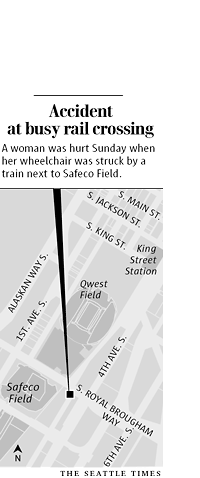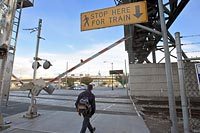Train accident was fourth near ballpark since 2000

A woman in a wheelchair who was struck by a train outside Safeco Field on Sunday may have gone around railroad-crossing arms recently installed to improve pedestrian safety, authorities investigating the accident said Monday.
The 39-year-old woman was on her way to work at Safeco Field around 9:30 a.m. when she was struck by a train while trying to cross the tracks at the intersection of South Royal Brougham and Fourth Avenue South. The woman, whose name was not released Monday, was in serious condition in the intensive-care unit at Harborview Medical Center and is expected to survive.
The crossing has been a source of concern for transportation and city of Seattle officials since before Safeco Field opened in 1999.
The woman is the fourth person struck by a train while crossing the tracks next to Safeco Field since 2000. One of the victims died. Railroad crossing arms, which come down to block pedestrians when a train is on the way, were installed this year.
There also have been discussions and plans to build a pedestrian bridge over the tracks, particularly since thousands of visitors to Mariners games must cross them to get to and from the stadium. But approval for the project and funding have not materialized.
A California man who was injured when he was struck by a train in 2004 filed a lawsuit this year claiming the city, the railroad, the state Transportation Department and the Mariners failed to protect pedestrians at the crossing.
But a railroad official said Monday that the crossing is no more dangerous than any other busy urban crossing.
According to a police report on Sunday's accident, the BNSF Railway train's engineer saw the woman in the wheelchair attempting to cross in the marked crossing area when he was about 100 feet away. He began blowing the whistle and applying the brakes but was unable to stop in time.
The police report did not say if the woman's wheelchair became stuck on the tracks.
The southbound train from Everett was traveling 18 mph when it struck the woman, according to a spokesman for the railroad company.
Police are investigating the possibility that she may have gone around the crossing arms, according to people familiar with the investigation.
According to Safeco Field spokeswoman Rebecca Hale, the injured woman worked on game days as an elevator host in the stadium. The Mariners played the Texas Rangers on Sunday in the team's final game of the season.
According to a police report, a woman who crossed the tracks safely said the gates came down as she was crossing, just before the woman in the wheelchair tried to do so.
Gus Melonas, a spokesman for BNSF, said the woman in the wheelchair had just cleared the tracks when the train hit the rear of her chair.
Since before Safeco Field opened in 1999, increased safety at that particular railroad crossing has been sought as part of a major traffic and safety overhaul of Highway 519, also known as Royal Brougham Way.
Originally, the idea was to tie Royal Brougham Way to Interstate 5, Interstate 90 and Highway 99 seamlessly with a separate pedestrian route.
Part of the project was completed in 2003 when South Atlantic Street, which now is called Edgar Martinez Way, was redesigned to carry traffic over the railroad tracks to interstates 5 and 90.
But approval and funding for the second phase of improvements to the traffic interchange — which called for a graded separation of train, vehicle and pedestrian traffic — has been stymied. Part of the problem is that funding dried up after Initiative 695 repealed the vehicle excise tax in favor of $30 car tabs. The initiative was overturned in the courts, but the state Legislature passed the tax cuts into law.
Another part of the problem is that eight agencies, including the city, the state Department of Transportation, the railroad companies and the Port of Seattle, have to sign off on the project.
"This is a situation that's been discussed, but is up in the air," Hale said.
Gregg Hirakawa, a former spokesman for the city's transportation department, said that while the city considers the intersection safe, the mayor has long urged improvements.
Hirakawa said the city had hoped to install the gates blocking pedestrians five years ago. But the gates weren't installed until earlier this year.
Melonas said trains are dangerous and people are urged to expect trains on the tracks and use caution. Still, he said, the Royal Brougham crossing is not any more dangerous than other busy urban crossings.
Melonas said that with freight trains, passenger trains, locomotive shifting and maintenance, there can be more than 100 train movements at that section on any given day.
"The tracks are busy and we tell people to expect movement of trains from either direction at any time," he said.
Garnet Gallinger, the California man who filed a lawsuit, suffered broken bones and a brain injury in 2004.
According to his wife, Gallinger was on his way to see the Mariners play the Oakland Athletics. He stopped to allow a northbound train to pass, then started to cross the tracks and was hit by a southbound train.
The first train blocked his view of the train that struck him, according to Gallinger's lawsuit.
Sigrid Laegreid, Miss Wheelchair Washington 2007, said crossing railroad tracks or other markedly uneven pathways while in a wheelchair can be difficult even under the best of circumstances.
"You have to hit the tracks at a perpendicular angle or else you can get stuck. It's really scary," she said.
Laegreid said she does not attempt to cross railroad tracks in her wheelchair, but she has been caught in sidewalk cracks and elevator crevices.
"I had a wheelchair tire get stuck once and it took three people to yank me out of it," she said. "You have to be really careful."
Christine Clarridge: 206-464-8983 or cclarridge@seattletimes.com
Seattle Times staff reporter Jennifer Sullivan contributed to this report.
